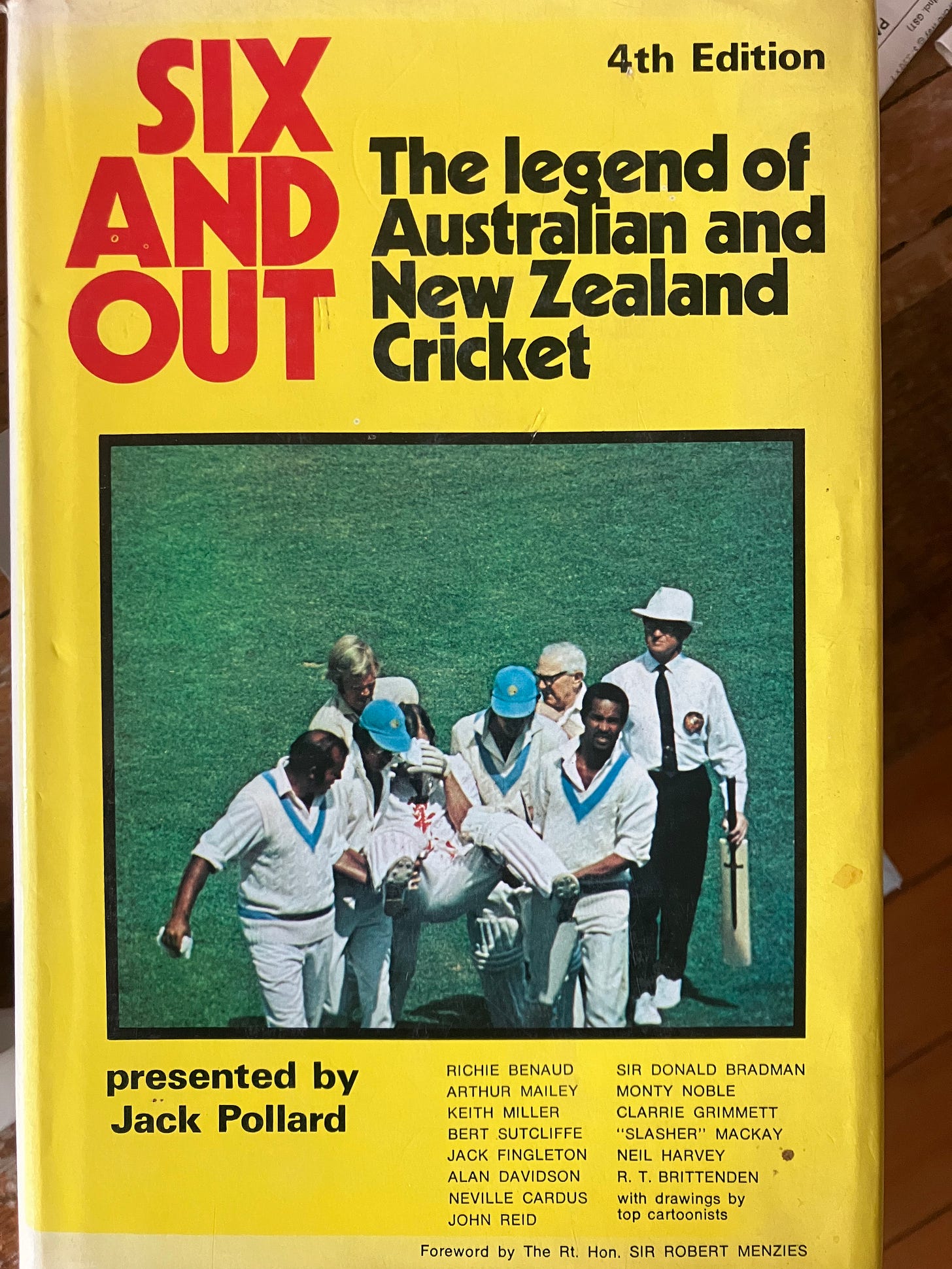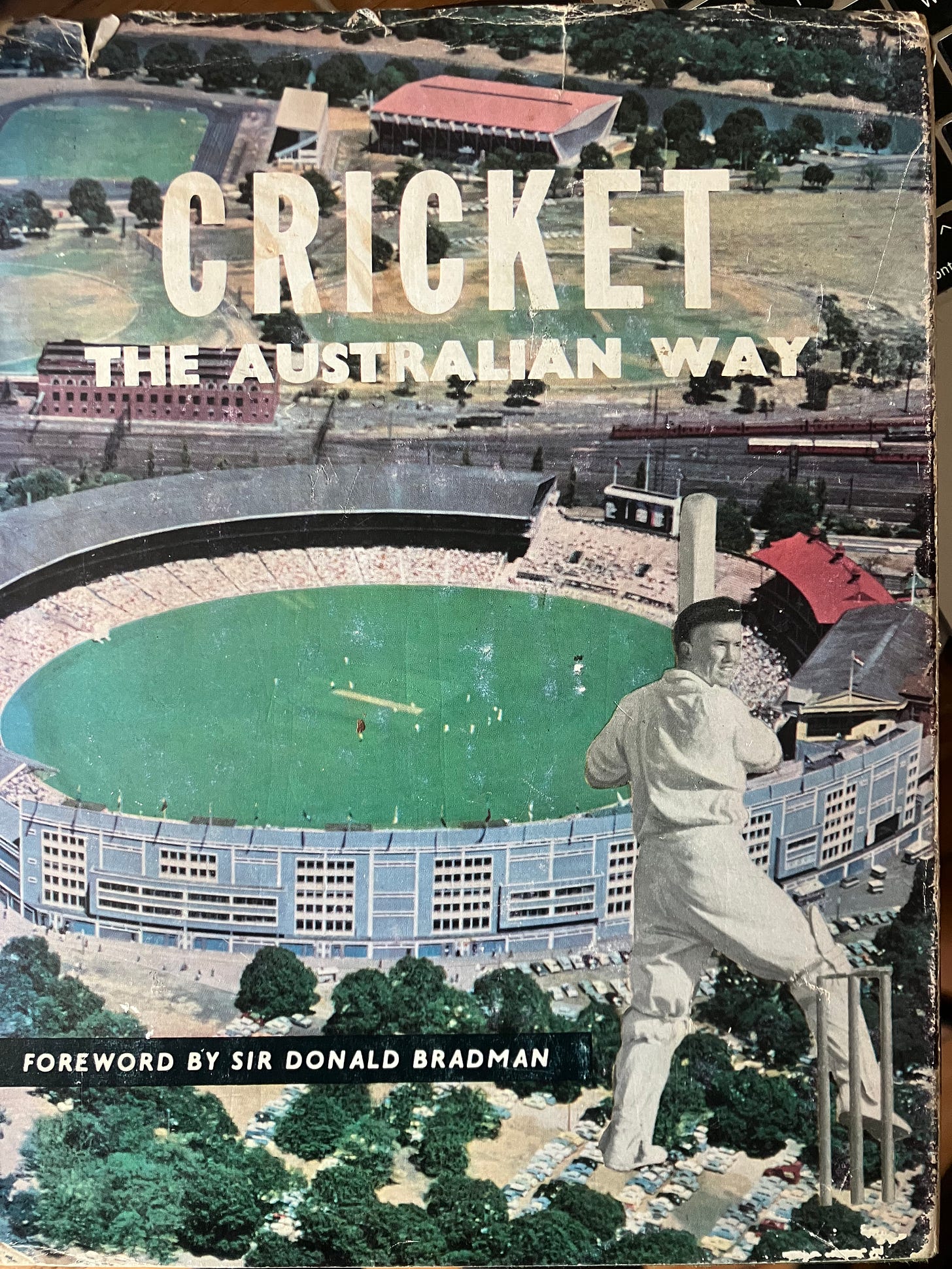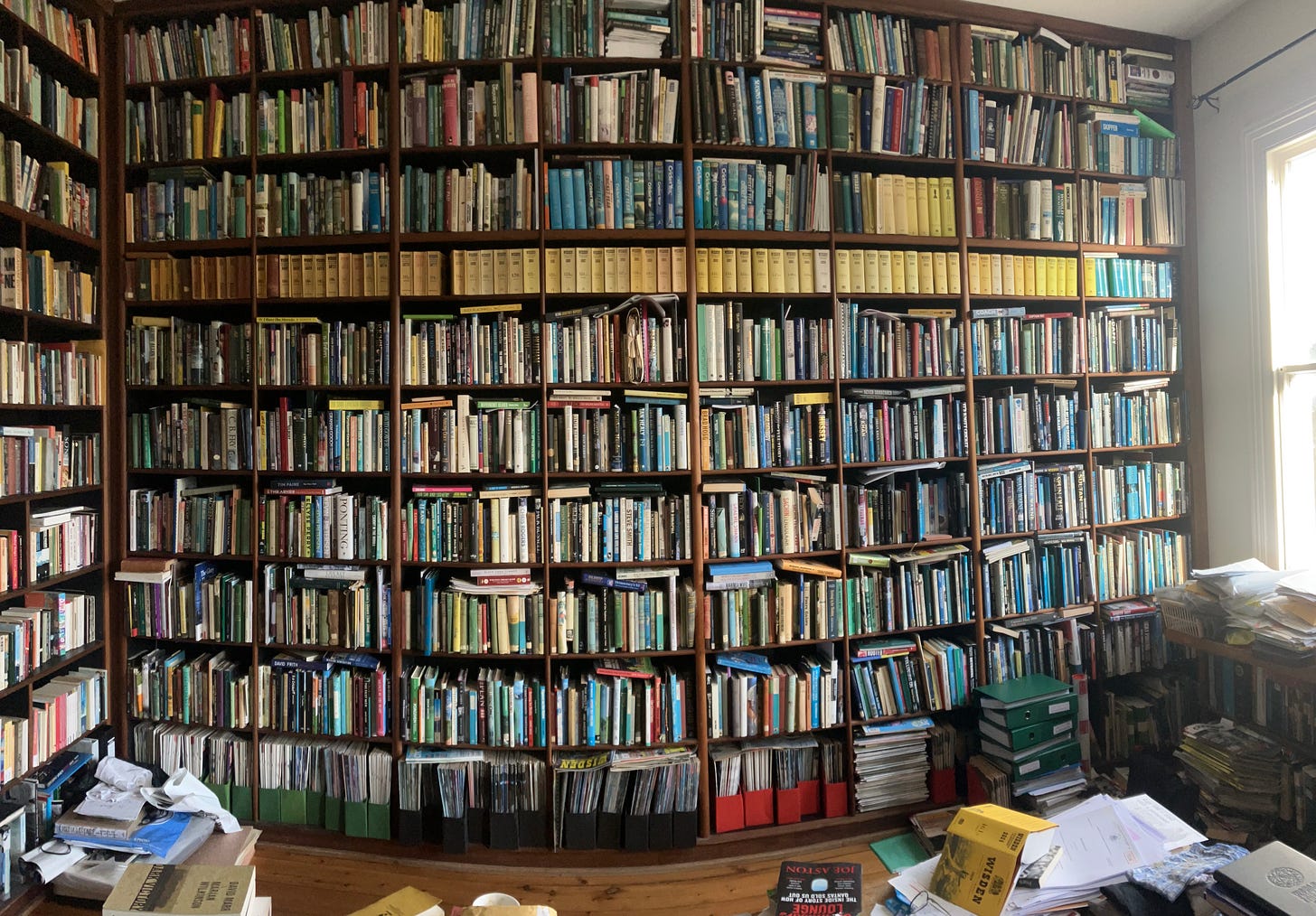Arthur Mailey once said that every cricket book was guaranteed sales of 7584, on the basis that there were 7584 people in the English-speaking world who bought every title published about the sport. Alas, that was long ago; life was simpler then. The pickings today are thinner, the publishers a great deal more circumspect. But there remains a pleasure in finding how cricket books endure.
This image landed a few weeks ago from a friend of Cricket Et Al, Tim Rogers. On tour in Europe, he had improbably come across a copy of Test Cricket: A Personal View. The book was published in 1977, even as author Tony Greig was making Test cricket too hot to hold him by taking the Packer shilling. In the intervening forty-seven years, this copy had shed its dust jacket, but otherwise was in good repair, and rendered Tim’s stay in a hotel in Lubeck more congenial. There is a comfort in such things - a sense of ourselves when young, a connection to the game’s continuities.
When I was a lad - coincidentally around the time of peak Greigy - cricket books abounded. Jack Pollard churned out titles like a Gestetner machine - multiple editions of Cricket: The Australian Way and of the anthology Six and Out, plus a range of illustrated histories.
Autobiographies proliferated: Ian Chappell’s Chappelli, Rod Marsh’s You’ll Keep, Dennis Lillee’s Back to the Mark, Max Walker’s Tangles inter alia. There also remained available the life stories of the preceding generation: Alan Davidson’s Fifteen Paces, Ray Lindwall’s Flying Stumps, Neil Harvey’s My World of Cricket, Bob Simpson’s Captain’s Story et al. And even if you didn’t quite understand the provenance of this literature at first, it was a little like chancing on the ruins of a former civilisation, unfamiliar but recognisable, in your local library or thrift store.
I know it’s laudator temporis acti to say so but the titles were better in those days: redolent Run-Digger by Bill Lawry, suavely cosmopolitan Tale of Two Tests and Willow Patterns by Richie Benaud, surgingly patriotic My Country’s Keeper by Wally Grout. I know that Benaud is memorialised by his commentary nostrums now, but nothing so brought him to life in my youthful imagination as Grout’s story from the hinge point of the 1961 Old Trafford Test. ‘Stay with me, Wal,’ said Benaud. ‘We’re going to win this game.’ And they did.
Anyway, there was a lot, and it was various. There were tour books. There were instructional books. There were annuals and almanacks. There was even Australian literature, notably that of Ray Robinson, limpid and discursive, and Jack Fingleton, shrewd and gnomic. Ray Robbie made enough in royalties from his first book, Between Wickets, to name his Northbridge home for it. Fingo walked evenly among prime ministers and potentates, in part because of cricket’s cachet, in part because he also covered federal politics - dual duties quite unthinkable in this era of arid specialisations.
Interestingly, there was nothing aimed specifically at kids, in the way that today’s notoriously reluctant readers are catered for by the tie-ins of Glenn Maxwell, David Warner and Nathan Lyon. Everything was pitched at a broadly adult readership, which had the effect of stretching your vocabulary and sensibilities a little. It was in Ian Redpath’s Always Reddy that I first encountered the word ‘vituperative’; I first read a line of Wordsworth in Frank Tyson’s Test of Nerves. And I dare say as many boys in my generation learned arithmetic from poring over cricket scores as they did in maths classes.
Somehow, too, you kept what you had. I regularly receive emails from readers now saying that an elderly relative has passed, and wondering what to do with their cricket books. There’s something melancholy about this, of course, but wonderful too - these little libraries, with their resonant names and happy associations, remained companions til the end. All those copies of A. G. Moyes’s A Century of Cricketers and Keith Miller’s Cricket Crossfire, inscribed with Christmas and birthday greetings, because an auntie or a sister knew that they liked cricket; all those well-thumbed cloth-bound Wisdens (with the Ravilious engraving) and/or Playfairs and Cricketers’ Who’s Whos too. Now free to a good home, only there aren’t, really, any.
Some day, someone is going to have to sort this out too. Because I’m damned if I’ll part with anything.
Because I dare say that few readers are nourishing cricket libraries now. We are awash in information; inundated by cricket in mass media, social media, podcasts and memes, we have hardly the patience for cricket between covers. Time poverty, attention span, competitive attractions: the same forces that beset Test cricket bear down on reading cricket. Which is ironic because it’s the game now that is various: by format and function, by geography and gender. Though there exist more subjects than ever, they are spread over fewer readers.
All the more reason, perhaps, to hold fast to what we have. Worthwhile works still appear every year. There were still sixteen pages devoted to books in Wisden this year. There are still a couple of pages each month in The Cricketer. And you may have noticed that this last week on Cricket Et Al we have been subtly parading a few of summer’s titles for your delectation: new books by Pat Cummins, Glenn Maxwell, Mark Ray and also me, while I’ve earlier looked at books about Frank Worrell and George Bonnor among others. Amid all the transience, there remains something sticky about a book: just ask our bibliophile captain. While Davey is less obviously a reader, he is not foreshadowing a tell-all Instagram post: he defiantly wants his bit of dead tree. There is even a book on its way about Arthur Mailey, which won’t sell 7584, but which will pleasantly fill a gap - I know because I’ve just written its foreword. So I’ll open the floor in the comments: what are the cricket books of your youth that have stayed with you?









Having lived and worked in St. Vincent in the mid 90's I read Beyond a Boundary (1963) a memoir on cricket written by the Trinidadian C. L. R. James. It was a fascinating history of Windies cricket through the lens of culture and colonial politics. By far the most important cricket book ever written!
Gideon, my father and I have well over 1000 cricket titles in our collection.
When he was a boarder from a dairy farm in Allora in Toowoomba from 1951-1954, a Wanderers side including Ken “Slasher” Mackay came to play the school XI and my Dad was Slasher’s host including carrying his personal belongings while he changed into his whites.
The first proper cricket book I ever read as a 10 year old book was Dad’s personally signed copy of “Slasher Opens Up”.
I have never stopped reading cricket books for 44 years and the comfort, solitude and familiarity they provide is a joy and solace.
Your writing has been a key part of that for a long time.